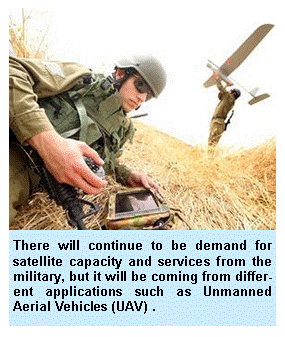Trends to Watch in 2013
by Virgil Labrador, Editor-Chief
Los Angeles, Calif., January 7, 2013--Shakespeare once said that the “past is prologue.” And the significant events of 2012 are a good portent of things to come in 2013 and beyond. Here are some of the events from 2012 that will shape and influence coming industry trends (not necessarily in order of significance):
SpaceX’s Dragon Spacecraft Delivers Cargo to the International Space Station (ISS). After the retirement of the Space Shuttle last year, the US no longer has a vehicle capable of delivering cargo to space. Private start-up company SpaceX filled that void in May when it successfully delivered a 1,000 lbs. cargo the ISS and successfully returned to earth. This significant achievement bodes well for the commercial development of space transportation.
With its fiscal problems, the U.S. has no choice but to rely on commercial providers for its current and future space transportation needs. The success of SpaceX paves the way for many other commercial providers, spurring competition and innovation.
Virgin Galactic Unveils LauncherOne low-cost launch vehicle. At the 2012 Farnborough Air Show, Virgin Galactic introduced its new low-cost launcher aimed at delivering small satellites to low-earth orbit. The Virgin Group led by visionary entrepreneur Richard Branson has already invested heavily in its Virgin Galactic space tourism venture. The entry of such a heavyweight company with a long track record of success will shake up the launch services industry as well as lead to other spin-off technologies for the satellite industry from the emerging space tourism industry.
Boeing’s new Electric Propulsion satellite. A major innovation that will help prolong satellite life and lower cost of satellites. It’s first two customers, regional operators SATMEX and Asia Broadcast Satellite, announced at the 2012 Satellite show a joint-procurement which levels the playing field among satellite operators by letting smaller operators have the benefit of the economies of scale usually reserved for the ‘Big Four’ operators.
The introduction of Intelsat’s EpicNG Satellite architecture. Announced at CommunicAsia in June 2012, Intelsat’s EpicNG Service which will incorporate some of the key features of High Throughput Ka-band satellites like spot beams and frequency re-use, with Ku– and C-band capacity. If anything else, this new service shifts some of the focus from Ka-band satellites and finds new purpose for C– and Ku-band capacity.
The launch of Viasat’s Exede In-flight broadband service. It’s official: satellite in-flight broadband is back and this time for good. Analysts project that by 2015 all airline flights will have some form of broadband connectivity.
Unlike it’s first iteration with Connexion by Boeing in the early 2000s, which resulted in a huge financial failure, the new in-flight broadband providers which includes On Air, Row44, GoGo, among others, are capitalizing on the strong demand for airline passengers to stay connected during flights. Welcome to the “always connected” world we now live in.
Here comes Ultra-High Definition TV (UHDTV). Ultra HD, also called 4K TV, was initially seen at CES 2012 in January and was heavily promoted at the IBC in September. During a press briefing on the eve of IBC, SES executives were very bullish on UHDTV, which they believe will be taking off sooner than most people think, perhaps as early as 2015. Eutelsat announced that it will broadcast the first Ultra HD channel in January 2013 and broadcast trials are scheduled in Korea in early 2013.
The increased bandwidth requirements of Ultra HD (as much as four times that of standard HD) can be a potential bonanza for satellite operators. However, prices have to come down drastically from the US$ 25K for a Ultra HD TV set and a critical mass of Ultra HD channels have to be launched in the next few years for Ultra HD to take off.
Changing Military Requirements The U.S. military budget was under intense scrutiny with the impending “Fiscal Cliff” which was narrowly averted by a last minute deal in Congress. Drastic cuts were avoided, temporarily but expect that the military satellite market will most likely remain flat while other vertical markets will grow such as oil and gas.

There will continue to be demand for satellite capacity and services from the military, but it will be coming from different applications such as Unmanned Aerial Vehicles (UAV) and might shift to other regions such as the Asia-Pacific, where booming economies and rising security tension are fueling military buildup.
U.S. Satellite Export Control Restrictions Relaxed. The satellite industry got a great Christmas gift when a bill was passed by congress that eases the export of satellit
e technology. The National Defense Authorization Act (NDAA) for Fiscal Year 2013 repealed some other more restrictive provisions that places satellite technology on the export control list. This is certainly good news for U.S. satellite companies who have been losing out on potentially billions of dollars in business abroad to its European and other counterparts. Expect more heated competition for contracts and procurements in emerging markets that U.S. companies were hitherto prohibited from participating.
Other developments to watch in 2013 include the following:
The launch of the first four all-Ka-band satellites in the O3b constellation is scheduled for the first half of 2013. The launch of O3b Ka-band satellites which will focus on the emerging markets in Latin America, Africa and Asia will be a bellwether for the viability of Ka-band satellites and applications. It will also be a good indicator of how vibrant the demand for satellite services are in the emerging markets.
In 2012, Asian satellite operators, Thaicom and AsiaSat announced a joint-venture to share capacity on an upcoming satellite to be called Asiasat 6/Thaicom 7. The increasing competition among satellite operators, which have so-called “Big Four” dominate the marketplace, are opening up new and creative ways for smaller operators to work together through joint ventures and procurements and capacity-sharing arrangements such as condosats and hosted payloads.
It’s always interesting to watch how the satellite industry reacts to changing customer requirements, global economic developments and increas
ed competition from other delivery systems. Over the years, even during the dot.com bust in the early 2000s and the global economic crisis of 2008-09, it has managed not only to survive but to prevail, posting modest growth rates every year since 1998. With the promising prospects, the industry should continue to do well in 2013 and beyond.
-------------------------------
 Virgil Labrador is the Editor-in-Chief of Satellite Market and Research based in Los Angeles, California. He is the author of two books on the satellite industry and has been covering the industry for various publications since 1998. Before that he worked in various capacities in the industry, including a stint as marketing director for the Asia Broadcast Center, a full-service teleport based in Singapore. He can be reached at virgil@satellitemarkets.com
Virgil Labrador is the Editor-in-Chief of Satellite Market and Research based in Los Angeles, California. He is the author of two books on the satellite industry and has been covering the industry for various publications since 1998. Before that he worked in various capacities in the industry, including a stint as marketing director for the Asia Broadcast Center, a full-service teleport based in Singapore. He can be reached at virgil@satellitemarkets.com





